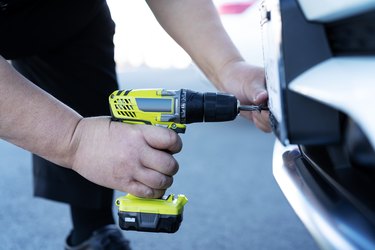
Cleaning your license plate isn't just a matter of keeping your car looking its best – it can also keep you from getting pulled over and ticketed. State laws generally require drivers to keep their license plates clean enough that the numbers are readable. It doesn't take long for a license plate to get filthy, especially in snowy or muddy conditions. Cleaning your car license plate is generally quick and easy with no trip to the car wash required.
Things You'll Need
Screwdriver
Hair dryer or heat gun (optional)
Plastic razor scraper (optional)
Rubbing alcohol or sticker solvent (optional)
Auto soap or dish soap
Microfiber cloth, paper towels or car wash sponge
Car wax
Rags
Rust remover or white vinegar (optional)
Wire brush (optional)
Video of the Day
Step 1: Remove the Plate
Use a screwdriver to remove the screws holding the license plate in place. Taking a plate off your car makes it easier to clean it thoroughly. That said, removing a plate isn't absolutely necessary for cleaning and may be more trouble than it's worth if the screws are stripped or rusty.
Video of the Day
If the screws are difficult to remove but you want to deal with it right away, you can try removing stripped screws using pliers or by holding a stretched rubber band over the head of the screw before inserting the screwdriver. To remove rusted screws, tap them gently with a hammer and apply a rust penetrant product. Let it soak according to package directions and then try the screws again.
Step 2: Remove Stickers if Necessary
Some states require drivers to apply registration stickers to the license plates. If it's time to put a new sticker on the plate, remove the old one(s) before cleaning. These stickers tend to be stubborn. Work carefully so you don't damage the plate.
Start by heating the sticker, which should soften the adhesive. Hold a hair dryer on low heat a few inches away from the sticker for 30 seconds or so. Next, work a plastic razor scraper under one corner of the sticker. As the sticker starts to come loose, hold the freed portion with one hand while sliding the scraper with the other. If any sticker residue remains when the sticker is gone, use a rag dampened with rubbing alcohol or commercial sticker solvent to remove it.
Step 3: Clean and Scrub the License Plate
Use auto soap or dish soap to clean a dirty license plate. (Dish soap shouldn't be used to wash the body of a car itself since it could damage the car's paint job and protective wax, but it shouldn't harm a metal license plate.) If you've removed the license plate from the car, soak it in a container of warm, soapy water for a few minutes. Use a microfiber cloth, paper towels or a clean car wash sponge to scrub away any dirt, bugs or other residue. Rinse the plate and dry it with a clean cloth.
If the license plate is still on the car, dip a car wash sponge in soapy water and use that to scrub the plate. Use a clean, wet sponge or a hose to wash away the suds.
Step 4: Apply Wax
Apply a thin layer of car wax to the clean license plate to protect the metal and help repel future stains. Depending on the product you buy, you might spray on wax or apply it with a soft cloth. Let the wax dry according to the package directions and then use a clean rag or microfiber cloth to buff the plate.
Step 5: Clean License Plate Frames
If you use simple metal or decorative license plate frames, make sure to clean them too. Scrubbing license plate frames with soapy water should be enough to wash away any mud or dirt. If your metal license plate frame has developed any rust, soak it overnight in white vinegar or spray it with a commercial rust remover. Brush the rusty areas with a wire brush.